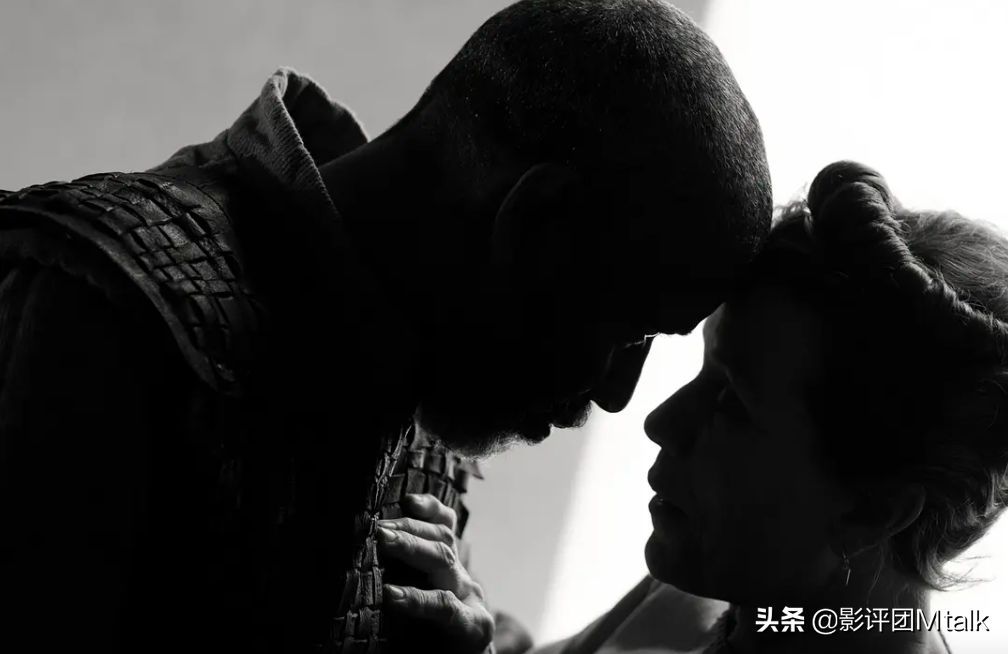
I once read a rule about animated cinema: make good use of the medium of animation with infinite possibilities to create plots that live-action movies can't achieve. The same principle applies to films that adapt stage plays. Joen Coen (hereinafter referred to as "Gao An"), the boss of the Gao An brothers, who wrote Shakespeare's classic tragedy "The Tragedy of Macbeth" for the first time, showed his proficiency in film skills. On the one hand, the director greatly retains the theatrical color of Shakespeare's original work, using tough stage lighting to focus on the moment when the characters meditate on their inner monologues; on the other hand, through the film's unique audiovisual language, it re-injects a strong and shocking film power into a classic script that is constantly being remade, so as not to let orthon Welles's "Macbeth" and Akira Kurosawa's "Spider's Nest" of the same pedigree be pre-emptive.
The reason why welles and Akira Kurosawa are mentioned to adapt the famous works of "Macbeth" is that Gao An chose a creative form that is very close to that of the two. The film's picture proportions follow the classic 1.37:1 academic scale, also shot in black and white, and also refer to Welles's favorite German expressionist approach—depicting people's minds in the strange sets of architectural structures, valuing extreme contrasts of light and shadow—and surrealizing the tragedy of Macbeth, manipulated by fate and ambition.
Now that Zhu Yu is in front, what is the significance of Gao An's re-shooting of the script of "Macbeth" in a similar iconic film style? I would like to cite three key passages that illustrate the magic of Gauhan's films to illustrate that this visually strong Macbeth is not Mike White.
Each director has a different interpretation of Macbeth's dramatic moments outside the door of King Duncan's bedroom, struggling to seize the throne. Welles takes several vaguely focused subjective shots and inner narration to show his mental state as a demon, Kurosawa shifts the focus of the drama to Lady Macbeth's incitement to him, and Gao An's "The Tragedy of Macbeth" has a passage about him standing in the corridor and seeing a doorknob shaped like a dagger, and then Macbeth begins to step forward, reciting his wish to kill the king. Thanks to art director Stefan Dechant's surreal and three-dimensional perspective of the black-and-white corridors, the contrasting lighting design with photographer Bruno Delbonnel allows each of Gaugan's storyboards (such as Macbeth's insert shot pulling out a dagger, and his close-up of the light from the shadows) to grasp the text and the atmosphere of the scene with great precision. In contrast to the abstract and symbolic depictions of Welles and Akira Kurosawa, Gao An's method is to concretely show the psychological struggles of the characters, so that the audience can follow Macbeth's murderous steps, pull open the dagger doorknob that reflects people's hearts, and intuitively feel his horror.
After Macbeth mercilessly stabs King Duncan to death, the film has an unexpected editing narrative process, the camera is close-up of Macbeth's blood-stained face, and suddenly, Mrs. Macbeth suddenly wakes up from her bed, as if sensing that her husband has carried out her plan. Her monologue on the bed is then cut in parallel with Macbeth's dead silence, recounting the chaos he witnessed. In addition to bringing out that she is a conspiracy, this monologue with the editing unconsciously becomes a narration, like the narrator narrating the story of the protagonist's encounter, there is nowhere to escape the sense of fatalism, and Welles's "Macbeth" opening witches rub Macbeth's mud in the mud as the same thematic significance. And the shot of Macbeth leaving the king's bed after looking down from above also greatly highlights his humble position below fate.
Shakespeare does not describe in detail the duel between Macbeth and Madoff in the original work, only that Macbeth was eventually removed from the first rank and the country returned to peace. Gao An's adaptation is the finishing touch to the original book, pointing out that Macbeth committed suicide due to greed. The film design Macbeth is in the middle of a duel when the crown above his head is knocked down. Originally, he could have killed Madoff who had fallen to the ground with a sword, but he chose to retrieve the crown on the ground first and fight again, and just before putting the crown on, he was beheaded by the resentful Madoff. Macbeth is in a critical situation, making the decision to forget his life for the sake of the void throne, and his fate is extremely frightening under the fog. Unlike Akira Kurosawa's large scene in the ending where the protagonist is killed by a thousand arrows, and Welles's use of ceramic dolls to be beheaded as a metaphor, Gao An's creation is more relevant to the small-scale original script, and has a thorough insight into Macbeth's personality.
The above three points may not fully explain Gao An's motivation for filming "The Tragedy of Macbeth". But for fans who have followed Gao An's film works for many years, they may be able to give them a good reason to revisit the familiar Shakespeare tragedy again. Because, this is a film noir in which Gao An meets Shakespeare. Text/FilmBurns